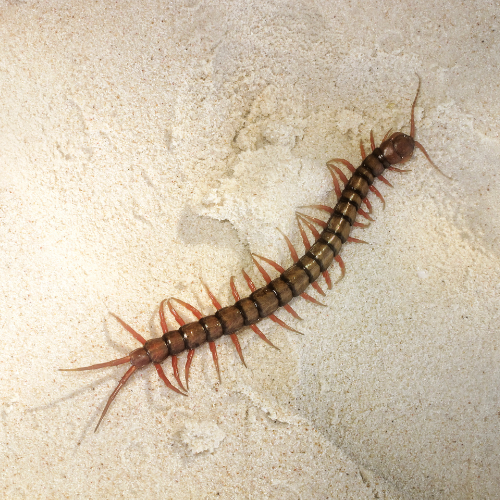Centipedes
Introduction to
Centipedes are fascinating yet often unwelcome guests in our homes and gardens. Known for their numerous legs and swift movements, these arthropods can be both beneficial and a nuisance. This guide provides detailed information on how to recognize, understand, and manage centipedes, including preventive measures and professional pest control solutions.
Recognition
Centipedes are easily recognizable by their elongated, segmented bodies and numerous legs. Each body segment typically has one pair of legs, resulting in a total count that can range from 15 to over 300 legs, depending on the species. They are usually yellowish to dark brown in color, often with darker stripes or markings. The most common indoor species is the house centipede, which has a distinctive long, thin body and legs that extend well beyond its body length, giving it a feathery appearance. Centipedes also have a pair of long antennae and sharp, pincer-like appendages near their heads, which they use to capture prey.
Biology
Centipedes belong to the class Chilopoda and are predatory arthropods. They undergo incomplete metamorphosis, developing from eggs to nymphs to adults. Female centipedes lay eggs in soil or leaf litter, and the young resemble miniature versions of adults. Centipedes have venomous claws called forcipules, which they use to inject venom into their prey. Their diet mainly consists of insects, spiders, and other small invertebrates, making them beneficial in controlling pest populations. However, their venom is generally not harmful to humans, though it can cause mild pain and swelling if they bite.
Habits
Centipedes are nocturnal and prefer moist, dark environments. Outdoors, they can be found under rocks, logs, leaf litter, and in soil. Indoors, they are commonly found in basements, bathrooms, kitchens, and other damp areas. Centipedes are solitary creatures and are typically seen alone. They are known for their speed and agility, which help them catch prey and escape predators. While they do not damage structures or household items, their presence can be unsettling due to their rapid movements and many legs.
Prevention
Preventing centipede infestations involves reducing moisture and eliminating hiding places. Use dehumidifiers in damp areas like basements and bathrooms. Seal cracks and gaps around doors, windows, and foundations to prevent centipedes from entering. Remove debris, leaf litter, and excess vegetation around the home’s exterior to reduce outdoor harborage areas. Regularly clean and declutter indoor spaces to minimize potential hiding spots. Additionally, reducing the population of insects and other prey in your home can make it less attractive to centipedes.
Professional
When centipedes become a persistent problem, professional pest control services can provide effective solutions. STL Pest Control offers thorough inspections and tailored treatment plans to address centipede infestations. Their methods include moisture control recommendations, sealing entry points, and targeted treatments to eliminate existing centipedes. Professional services ensure that the infestation is managed efficiently and safely, reducing the inconvenience and potential distress caused by these pests.



Our Office









